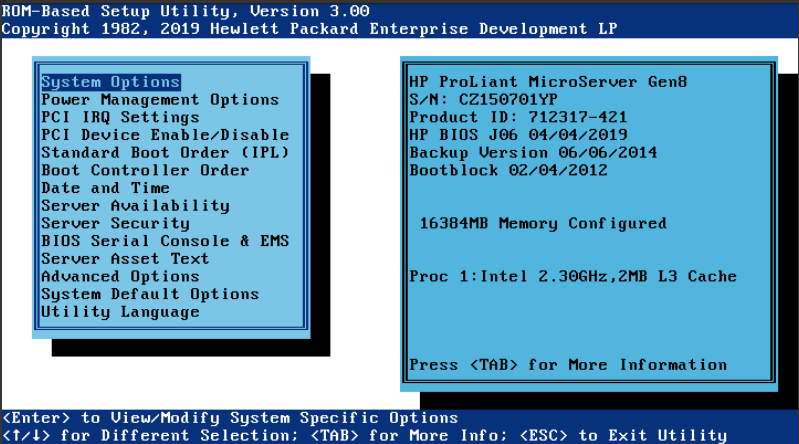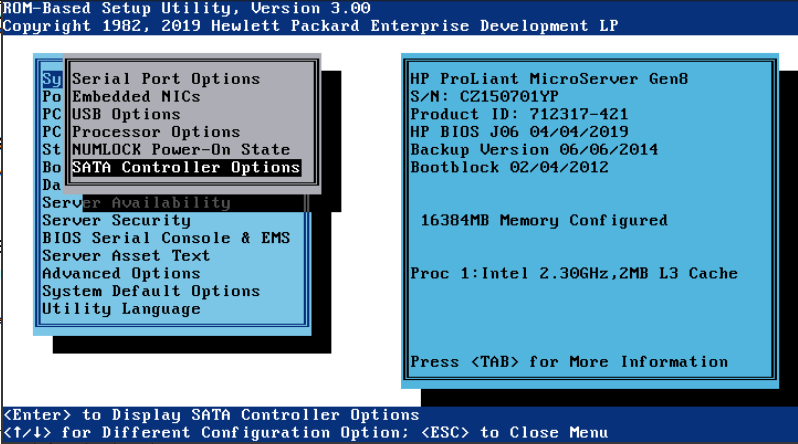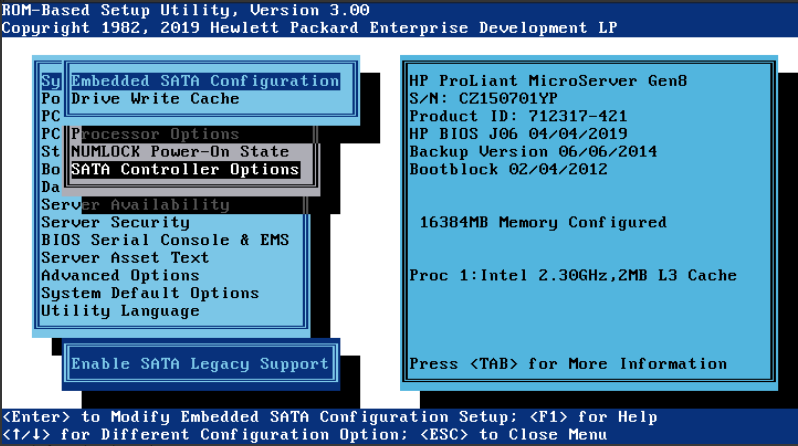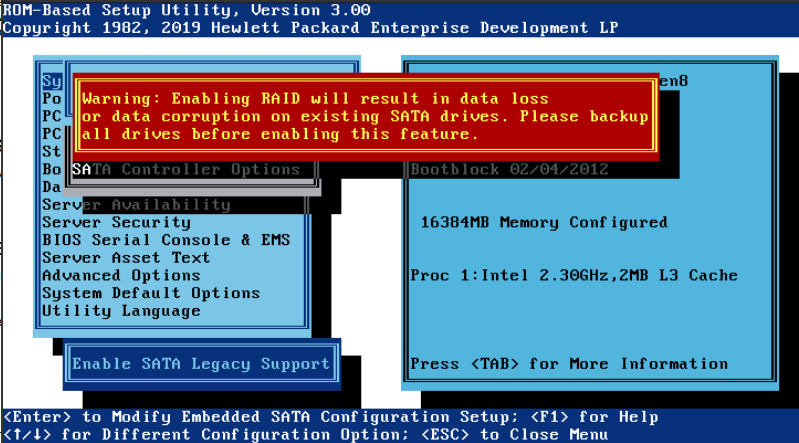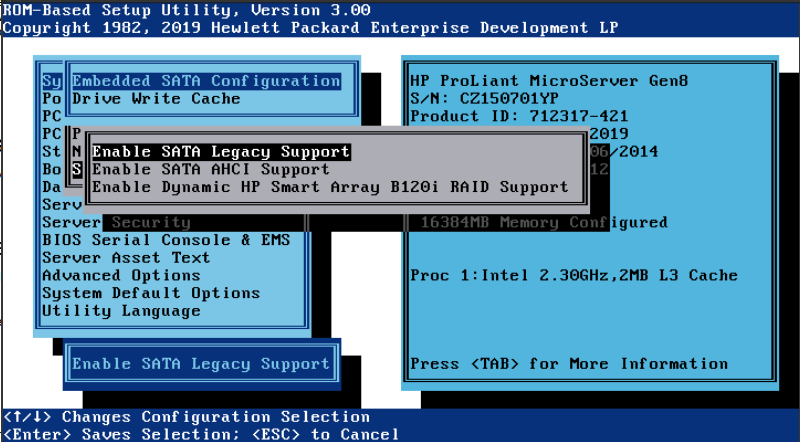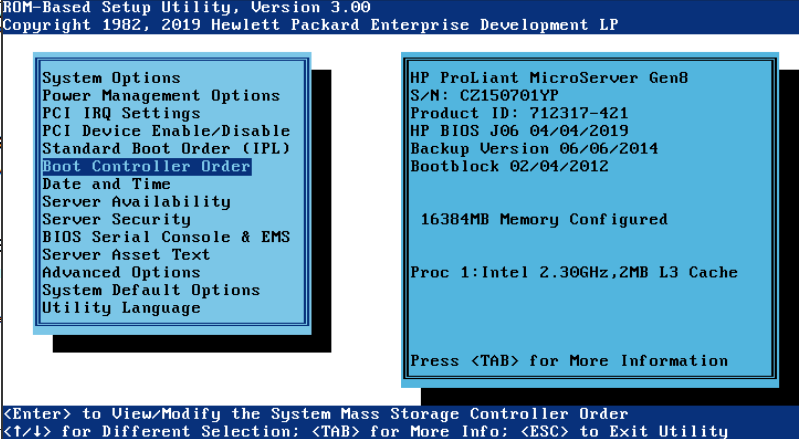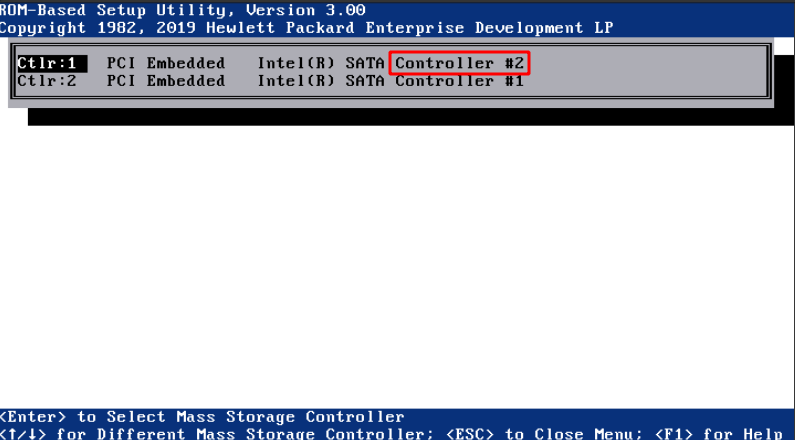This is an old revision of the document!
Table of Contents
Especificaciones
Xarxa
LACP
tplink TL-SG1024DE
https://www.tp-link.com/es/support/faq/991/?utm_medium=select-local
La IP del switch es 192.168.0.1. Nos ponemos un ip de ese rango (por ejemplo 192.168.0.2) y accedemos vía web:
admin/admin
Para configurar LACP vamos a System / switching / Port Trunk
ILO
| Server | Server 1 (docker) | Server 2 (nas) | Server 3 | Server 4 (proxmox) |
|---|---|---|---|---|
| ILO | 192.168.1.21 | 192.168.1.22 | 192.168.1.23 | 192.168.1.24 |
| ILO | ippública:8081 | ippública:8082 | ippública:8083 | ippública:8084 |
| ILO | d0:bf:9c:45:dd:7e | d0:bf:9c:45:d8:b6 | d0:bf:9c:45:d4:ae | d0:bf:9c:45:d7:ce |
| ETH1 | d0:bf:9c:45:dd:7c OK | d0:bf:9c:45:d8:b4 | d0:bf:9c:45:d4:ac OK | d0:bf:9c:45:d7:cc ok |
| ETH2 | d0:bf:9c:45:dd:7d | d0:bf:9c:45:d8:b5 ok | d0:bf:9c:45:d4:ad | d0:bf:9c:45:d7:cd |
| RAM | 10GB (8+2) | 4Gb (2+2) | 16Gb (8+8) | 10Gb (8+2) |
| DISCO | 480Gb + 480Gb | 4x8TB | 480Gb + 480Gb | 1,8Tb + 3Gb |
| IP | 192.168.1.200 | 192.168.1.250 | 192.168.1.32 | 192.168.1.33 |
Usuario ILO ruth/C9
Configurar ILO
Al arrancar pulsar F8 (Ilo 4 Advanced press [F8] to configure)
Actualizar ILO
Descargar:
http://www.hpe.com/support/ilo4
Si es un exe, descomprimir y coger el bin. Se sube en la web de la ILO: overview / iLO Firmware Version
Agente ILO
Para ver mas info en la ILO como el disco duro, añadir a sources:
deb http://downloads.linux.hpe.com/SDR/repo/mcp stretch/current-gen9 non-free apt-key adv --keyserver keyserver.ubuntu.com --recv-keys C208ADDE26C2B797 apt-get install hp-ams
BIOS
Tiene que tener instalado hp-ams para que detecte la ILO.
Yo lo he hecho con debian. Descargamos el software rpm de i386
Lo convertimos a deb. Lo instalamos:
dpkg --add-architecture i386 dpkg -i firmware-system-j06_2019.04.04-2.1_i386.deb cd /usr/lib/i386-linux-gnu/firmware-system-j06-2019.04.04-1.1/
./hpsetup
Flash Engine Version: Linux-1.5.9.5-2 Name: Online ROM Flash Component for Linux - HP ProLiant MicroServer Gen8 (J06) Servers New Version: 04/04/2019 Current Version: 06/06/2014 The software is installed but is not up to date. Do you want to upgrade the software to a newer version (y/n) ?y Flash in progress do not interrupt or your system may become unusable. Working........................................................ The installation procedure completed successfully. A reboot is required to finish the installation completely. Do you want to reboot your system now? yes
NAS
Para que arranque del SSD puesto en el CDROM hay que cambiar en la BIOS:
Pulsar F9 para etrar en BIOS
Cambiar a modo Legacy y el controller el 2, que es el CDROM en vez de los 4 discos
Configuración del RAID
blkid
/dev/md0: UUID="955edf36-f785-441e-95e6-ff7cd77fc510" TYPE="ext4" /dev/sda1: UUID="ba93d654-1e00-4b85-b2f1-f9930af9cc43" UUID_SUB="f61e84e9-271d-a311-9ae4-6eca19a84c10" LABEL="nas:0" TYPE="linux_raid_member" PARTUUID="b638f829-b354-4953-9e08-f96c8f4f031d" /dev/sdb1: UUID="ba93d654-1e00-4b85-b2f1-f9930af9cc43" UUID_SUB="6984a8d2-694a-b00b-0f23-809b2c123924" LABEL="nas:0" TYPE="linux_raid_member" PARTUUID="c9f7459b-cef8-434c-8a41-a471989eee60" /dev/sdc1: UUID="ba93d654-1e00-4b85-b2f1-f9930af9cc43" UUID_SUB="12d795a6-a34e-feec-4c8f-6ad962a59536" LABEL="nas:0" TYPE="linux_raid_member" PARTUUID="eebd20a6-6f32-46a9-9015-adc50649514a" /dev/sde1: UUID="a7edb0b3-d69b-43da-9dc6-66d046c4e344" TYPE="ext4" PARTUUID="c3c3e823-01" /dev/sde5: UUID="b5c2a2a5-7217-4ab0-bdd9-55469ddcfaf9" TYPE="swap" PARTUUID="c3c3e823-05" /dev/sdd1: UUID="ba93d654-1e00-4b85-b2f1-f9930af9cc43" UUID_SUB="cfd1a1fd-d4c7-a1f8-0779-c235b8784b5b" LABEL="nas:0" TYPE="linux_raid_member" PARTUUID="ca58c1f5-abc7-4b18-b5ae-f738788cb1ea" /dev/sdf1: PARTUUID="0e2b0ddc-a8e9-11e9-a82e-d0bf9c45d8b4" /dev/sdf2: LABEL="freenas-boot" UUID="15348038225366585637" UUID_SUB="12889063831144199016" TYPE="zfs_member" PARTUUID="0e4dff28-a8e9-11e9-a82e-d0bf9c45d8b4"
Ponemos en /etc/fstab
UUID=955edf36-f785-441e-95e6-ff7cd77fc510 /mnt/raid ext4 defaults 0 2
Desde 192.168.1.32
showmount -e 192.168.1.250
Export list for 192.168.1.250: /mnt/dades/media 192.168.1.0
Montamos el recurso:
mkdir /nfs mount 192.168.1.250:/mnt/dades/media /nfs
root@nas:/mnt/raid# apt-get install nfs-kernel-server
root@nas:/mnt/raid# cat /etc/exports /mnt/raid/nfs 192.168.1.0/255.255.255.0(rw,async,subtree_check,no_root_squash)
Reiniciamos el servicio root@nas:/mnt/raid# exportfs -rav exporting 192.168.1.0/255.255.255.0:/mnt/raid/nfs
En el cliente instalamos nfs: apt-get install nfs-common
Mostramos si lo ve root@avtp239:~# showmount -e 192.168.1.250 Export list for 192.168.1.250: /mnt/raid/nfs 192.168.1.0/255.255.255.0
Lo montamos root@avtp239:/mnt# mount -t nfs 192.168.1.250:/mnt/raid/nfs /mnt/nfs
Wake on lan (wakeonlan)
F9
Server Avalilability
Wake-On Lan
server 3
Para levantar un servidor, instalar el paquete wakeonlan y ejecutar con la mac de eth1:
wakeonlan <MAC>
Por ekemplo:
wakeonlan d0:bf:9c:45:dd:7c
Kubernetes
Instalar docker y cambiar driver cgroups
https://kubernetes.io/docs/setup/production-environment/container-runtimes/
https://kubernetes.io/docs/setup/production-environment/tools/kubeadm/install-kubeadm/
apt-get update && apt-get install -y apt-transport-https curl curl -s https://packages.cloud.google.com/apt/doc/apt-key.gpg | apt-key add - cat <<EOF >/etc/apt/sources.list.d/kubernetes.list deb https://apt.kubernetes.io/ kubernetes-xenial main EOF apt-get update apt-get install -y kubelet kubeadm kubectl apt-mark hold kubelet kubeadm kubectl
root@kubernetes2:~# swapoff -a
root@kubernetes2:~# kubeadm init
[init] Using Kubernetes version: v1.15.1
[preflight] Running pre-flight checks
[WARNING IsDockerSystemdCheck]: detected "cgroupfs" as the Docker cgroup driver. The recommended driver is "systemd". Please follow the guide at https://kubernetes.io/docs/setup/cri/
[preflight] Pulling images required for setting up a Kubernetes cluster
[preflight] This might take a minute or two, depending on the speed of your internet connection
[preflight] You can also perform this action in beforehand using 'kubeadm config images pull'
[kubelet-start] Writing kubelet environment file with flags to file "/var/lib/kubelet/kubeadm-flags.env"
[kubelet-start] Writing kubelet configuration to file "/var/lib/kubelet/config.yaml"
[kubelet-start] Activating the kubelet service
[certs] Using certificateDir folder "/etc/kubernetes/pki"
[certs] Generating "ca" certificate and key
[certs] Generating "apiserver" certificate and key
[certs] apiserver serving cert is signed for DNS names [kubernetes2 kubernetes kubernetes.default kubernetes.default.svc kubernetes.default.svc.cluster.local] and IPs [10.96.0.1 192.168.1.32]
[certs] Generating "apiserver-kubelet-client" certificate and key
[certs] Generating "etcd/ca" certificate and key
[certs] Generating "apiserver-etcd-client" certificate and key
[certs] Generating "etcd/server" certificate and key
[certs] etcd/server serving cert is signed for DNS names [kubernetes2 localhost] and IPs [192.168.1.32 127.0.0.1 ::1]
[certs] Generating "etcd/peer" certificate and key
[certs] etcd/peer serving cert is signed for DNS names [kubernetes2 localhost] and IPs [192.168.1.32 127.0.0.1 ::1]
[certs] Generating "etcd/healthcheck-client" certificate and key
[certs] Generating "front-proxy-ca" certificate and key
[certs] Generating "front-proxy-client" certificate and key
[certs] Generating "sa" key and public key
[kubeconfig] Using kubeconfig folder "/etc/kubernetes"
[kubeconfig] Writing "admin.conf" kubeconfig file
[kubeconfig] Writing "kubelet.conf" kubeconfig file
[kubeconfig] Writing "controller-manager.conf" kubeconfig file
[kubeconfig] Writing "scheduler.conf" kubeconfig file
[control-plane] Using manifest folder "/etc/kubernetes/manifests"
[control-plane] Creating static Pod manifest for "kube-apiserver"
[control-plane] Creating static Pod manifest for "kube-controller-manager"
[control-plane] Creating static Pod manifest for "kube-scheduler"
[etcd] Creating static Pod manifest for local etcd in "/etc/kubernetes/manifests"
[wait-control-plane] Waiting for the kubelet to boot up the control plane as static Pods from directory "/etc/kubernetes/manifests". This can take up to 4m0s
[apiclient] All control plane components are healthy after 37.503359 seconds
[upload-config] Storing the configuration used in ConfigMap "kubeadm-config" in the "kube-system" Namespace
[kubelet] Creating a ConfigMap "kubelet-config-1.15" in namespace kube-system with the configuration for the kubelets in the cluster
[upload-certs] Skipping phase. Please see --upload-certs
[mark-control-plane] Marking the node kubernetes2 as control-plane by adding the label "node-role.kubernetes.io/master=''"
[mark-control-plane] Marking the node kubernetes2 as control-plane by adding the taints [node-role.kubernetes.io/master:NoSchedule]
[bootstrap-token] Using token: 5h71z5.tasjr0w0bvtauxpb
[bootstrap-token] Configuring bootstrap tokens, cluster-info ConfigMap, RBAC Roles
[bootstrap-token] configured RBAC rules to allow Node Bootstrap tokens to post CSRs in order for nodes to get long term certificate credentials
[bootstrap-token] configured RBAC rules to allow the csrapprover controller automatically approve CSRs from a Node Bootstrap Token
[bootstrap-token] configured RBAC rules to allow certificate rotation for all node client certificates in the cluster
[bootstrap-token] Creating the "cluster-info" ConfigMap in the "kube-public" namespace
[addons] Applied essential addon: CoreDNS
[addons] Applied essential addon: kube-proxy
Your Kubernetes control-plane has initialized successfully!
To start using your cluster, you need to run the following as a regular user:
mkdir -p $HOME/.kube
sudo cp -i /etc/kubernetes/admin.conf $HOME/.kube/config
sudo chown $(id -u):$(id -g) $HOME/.kube/config
You should now deploy a pod network to the cluster.
Run "kubectl apply -f [podnetwork].yaml" with one of the options listed at:
https://kubernetes.io/docs/concepts/cluster-administration/addons/
Then you can join any number of worker nodes by running the following on each as root:
kubeadm join 192.168.1.32:6443 --token 5h71z5.tasjr0w0bvtauxpb \
--discovery-token-ca-cert-hash sha256:7d1ce467bfeb50df0023d439ef00b9597c3a140f5aa77ed089f7ee3fbee0d232
root@kubernetes2:~#
root@kubernetes2:~#
Desplegar una app:
https://kubernetes.io/docs/tutorials/kubernetes-basics/deploy-app/deploy-intro/
ruth@kubernetes2:~$ kubectl create deployment hello-node --image=gcr.io/hello-minikube-zero-install/hello-node
deployment.apps/hello-node created
ruth@kubernetes2:~$ kubectl get deployments
NAME READY UP-TO-DATE AVAILABLE AGE
hello-node 0/1 1 0 10s
ruth@kubernetes2:~$ kubectl get pods
NAME READY STATUS RESTARTS AGE
hello-node-55b49fb9f8-fw2nh 1/1 Running 0 51s
ruth@kubernetes2:~$ kubectl get events
LAST SEEN TYPE REASON OBJECT MESSAGE
73s Normal Scheduled pod/hello-node-55b49fb9f8-fw2nh Successfully assigned default/hello-node-55b49fb9f8-fw2nh to kubernetes3
72s Normal Pulling pod/hello-node-55b49fb9f8-fw2nh Pulling image "gcr.io/hello-minikube-zero-install/hello-node"
38s Normal Pulled pod/hello-node-55b49fb9f8-fw2nh Successfully pulled image "gcr.io/hello-minikube-zero-install/hello-node"
29s Normal Created pod/hello-node-55b49fb9f8-fw2nh Created container hello-node
29s Normal Started pod/hello-node-55b49fb9f8-fw2nh Started container hello-node
73s Normal SuccessfulCreate replicaset/hello-node-55b49fb9f8 Created pod: hello-node-55b49fb9f8-fw2nh
73s Normal ScalingReplicaSet deployment/hello-node Scaled up replica set hello-node-55b49fb9f8 to 1
ruth@kubernetes2:~$ kubectl config view
apiVersion: v1
clusters:
- cluster:
certificate-authority-data: DATA+OMITTED
server: https://192.168.1.32:6443
name: kubernetes
contexts:
- context:
cluster: kubernetes
user: kubernetes-admin
name: kubernetes-admin@kubernetes
current-context: kubernetes-admin@kubernetes
kind: Config
preferences: {}
users:
- name: kubernetes-admin
user:
client-certificate-data: REDACTED
client-key-data: REDACTED
Creamos un servicio:
ruth@kubernetes2:~$ kubectl expose deployment hello-node --type=LoadBalancer --port=8080 service/hello-node exposed ruth@kubernetes2:~$ kubectl get services NAME TYPE CLUSTER-IP EXTERNAL-IP PORT(S) AGE hello-node LoadBalancer 10.99.215.55 <pending> 8080:32151/TCP 11s kubernetes ClusterIP 10.96.0.1 <none> 443/TCP 16h
Para borrarlo:
kubectl delete service hello-node kubectl delete deployment hello-node

